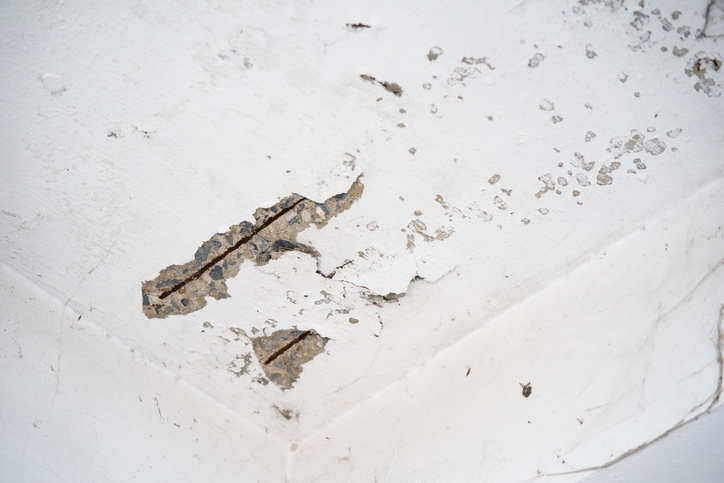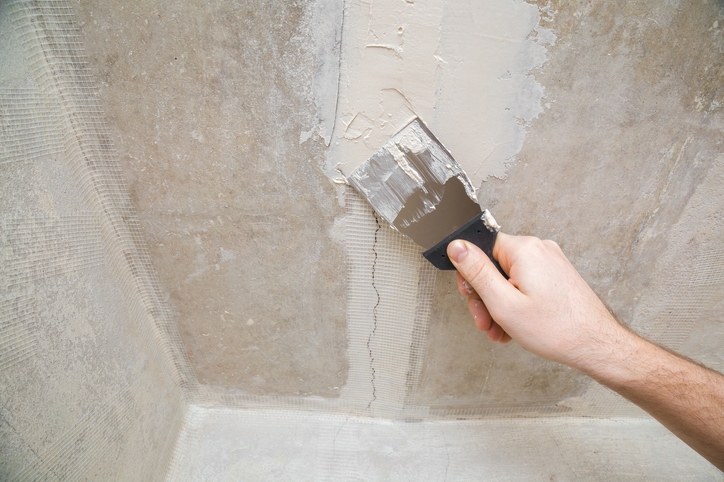Most San Jose and surrounding Bay area commercial buildings have at least two stories, while many have basements and underground spaces. This is why concrete ceilings are a sensible and practical building choice for commercial buildings since they help reinforce these structures and their load-bearing properties.
There’s no doubt that concrete is a superior building material. But like other building materials, concrete may deteriorate when it’s not regularly maintained. It is important to note that concrete buildings are subject to movement over time, causing cracks in walls, floors, and ceilings. These issues should not be overlooked.
Many commercial painters in Fremont, CA, offer other services such as concrete ceiling repair. Such repairs are essential to restore the concrete ceiling’s original appearance and make it structurally sound and stable. Concrete ceiling repair and strengthening are crucial to commercial buildings mainly for safety reasons. But other factors, such as aesthetic appeal and savings on time and money, are also important.
If your commercial building has noticeable stains or cracks on its concrete ceilings, Custom Painting, Inc. can expertly address such issues to restore concrete ceilings to their original appearance and maintain their structural integrity.
The common issues in concrete ceilings
Concrete ceilings, while durable and strong, can be susceptible to a range of issues over time or due to specific conditions. Here are some common problems:
- Cracking – One of the most common issues with concrete ceilings is the formation of cracks. These can be caused by thermal expansion and contraction, structural settling, or excessive loads. Cracks may be superficial or indicate deeper structural problems.
- Spalling – This issue occurs when the concrete begins to break off in chunks, often exposing the reinforcing steel within. Spalling can be caused by corrosion of the steel reinforcement (due to water ingress and the presence of salts), freeze-thaw cycles, or poor concrete mix during construction.
- Leakage and water damage – Concrete is porous and can absorb water, leading to leakage through the ceiling. It is a particular problem in buildings with flat concrete roofs. Continuous exposure to water can lead to structural damage, mold growth, and deterioration of interior finishes.
- Efflorescence – This is the formation of white, powdery deposits on the surface of the concrete, caused by the migration of soluble salts to the surface where they crystallize. While not structurally damaging, efflorescence can be unsightly and difficult to remove.
- Thermal conductivity – Concrete has high thermal conductivity, meaning it can easily transfer heat. Without proper insulation, concrete ceilings can lead to increased heating and cooling costs and contribute to uncomfortable temperature fluctuations inside the building.
- Acoustic issues – Concrete is a hard surface that reflects sound, which can lead to echoes and increased noise levels within a space. Concrete buildings may require special acoustic treatments to manage sound quality.
- Aesthetic limitations – While some appreciate the industrial or modern look of exposed concrete, it can be seen as too stark or cold by others. Additionally, options for modifying the appearance of a concrete ceiling (e.g., painting, adding decorative finishes) can be limited compared to other materials.
The importance of concrete ceiling maintenance
Maintaining concrete ceilings is crucial for several reasons, spanning both aesthetic and structural integrity concerns. Here’s a breakdown of the key reasons:
- Durability – Concrete is a highly durable material. But over time, it can be subjected to various forms of wear and tear, such as cracking, spalling (where pieces of concrete break away), or efflorescence (a whitish powder that forms on the surface due to water evaporation). Regular maintenance helps address these issues early on, preventing them from worsening and thereby extending the lifespan of the concrete ceiling.
- Structural integrity – Regular maintenance ensures the structural integrity of the concrete ceiling. This is crucial in buildings where safety and durability are paramount. Addressing minor issues before they escalate can prevent significant structural failures, which could lead to costly repairs or, worse, catastrophic events.
- Aesthetics – Concrete ceilings, especially in modern or industrial-style interiors, can be a significant aesthetic feature. Maintaining these ceilings helps preserve their appearance, ensuring they remain an attractive part of the building’s interior. This includes cleaning and repairing any visible defects that can detract from the overall look of the space.
- Moisture control – Maintenance can help in managing moisture levels in concrete ceilings. Concrete is porous and can absorb moisture, leading to problems like mold and mildew growth, which not only affect the ceiling’s appearance but can also lead to health issues for occupants. Regular checks and repairs can prevent moisture from becoming a problem.
- Insulation and energy efficiency – Cracks or holes in concrete ceilings can affect a building’s thermal envelope, leading to increased heating or cooling costs. By sealing these defects, you can improve insulation, contributing to better energy efficiency and comfort for occupants.
- Property value – Regular maintenance of concrete ceilings, as part of overall building maintenance, can help preserve or even increase the property value. Sunnyvale area buildings that are well-maintained are more attractive to buyers and tenants, as they indicate lower future repair needs.
How does Custom Painting repair concrete ceilings?
Repairing cracks in concrete ceilings involves several steps to ensure durable and effective repair. Here’s a comprehensive guide on how to fix cracks in concrete ceilings:
1. Assess the damage
- Examine the crack’s width, depth, and length.
- Determine if it’s structural (affects the building’s integrity) or superficial. For structural cracks, consult a professional.
2. Clean the cracks
- We use a wire brush or vacuum to remove loose concrete, dust, and debris from the crack.
- For wider cracks, we may need to use a chisel and hammer to remove any unstable concrete and create a slightly wider base within the crack for better filler adhesion.
3. Apply a concrete bonding adhesive (Optional)
- For deeper or wider cracks, we may apply a concrete bonding adhesive inside the crack that can help the repair material adhere better.
- Let the adhesive slightly dry as per the manufacturer’s instructions.
4. Prepare the filler material
- Mix the concrete patching compound according to the manufacturer’s instructions. For small cracks, a ready-to-use filler can be more convenient.
5. Fill the cracks
- We usually use a putty knife or trowel to press the filler material into the crack, ensuring it’s completely filled and compacted. Then, we overfill slightly to account for shrinkage as the filler dries.
6. Smooth the surface
- Smooth the filler material flush with the ceiling’s surface using a putty knife or trowel.
- If we deal with a textured ceiling, we try to mimic the texture while smoothing out the filler.
7. Allow to dry
- Let the filler material dry completely. Drying times may vary depending on the product and the environment.
8. Sanding (if necessary)
- Once dry, we lightly sand the repaired area with fine-grit sandpaper to achieve a smooth, consistent surface with the surrounding area.
9. Painting or Finishing
- Apply primer and paint to match the ceiling’s finish, if necessary.
- For unpainted concrete, we may leave it as is or apply a concrete sealant for protection.
10. Monitor
- After the repair, we keep an eye on the repaired crack and surrounding area for any signs of movement or further cracking, which could indicate underlying structural issues.
Notes:
- For significant, recurring, or structural cracks, it’s crucial to consult with a structural engineer or professional contractor to determine the underlying cause and appropriate repair methods to ensure the safety and integrity of the building.
- Cracks that go all over the current slab may be addressed by installing a new concrete ceiling. Slabs can either be prefabricated and transported to the site or poured on site.
Contact Custom Painting, Inc.!
Maintaining concrete ceilings is an integral part of building upkeep that ensures safety, enhances longevity, maintains aesthetic appeal, and contributes to energy efficiency and property value. Regular inspections and timely repairs are key to addressing potential issues before they escalate into major problems.
Professional contractors, such as Custom Painting, Inc., address the issues that affect concrete ceilings. These issues often require proper design and construction techniques, including adequate reinforcement, proper concrete mix, sealing, and regular maintenance to guarantee concrete ceiling’s top performance and longevity. By identifying the underlying causes early, our crew can start working on the most effective and long-lasting solutions.
If you need concrete ceiling repairs and maintenance, contact us by phone 925-866-9610 or fill out an online form to schedule an appointment with us. We always provide job estimates free of charge.



